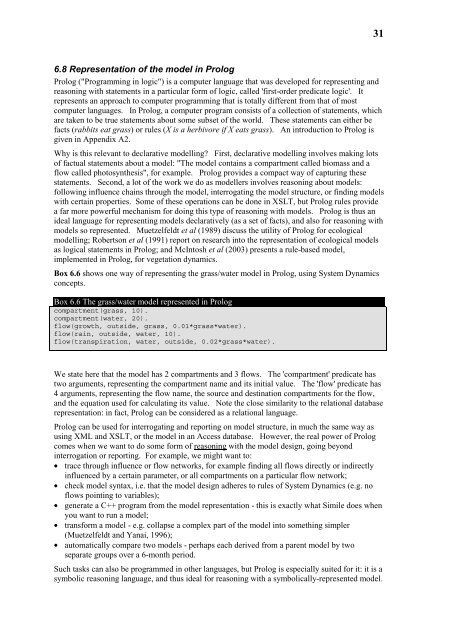pdf: 600KB - Potsdam Institute for Climate Impact Research
pdf: 600KB - Potsdam Institute for Climate Impact Research
pdf: 600KB - Potsdam Institute for Climate Impact Research
You also want an ePaper? Increase the reach of your titles
YUMPU automatically turns print PDFs into web optimized ePapers that Google loves.
31<br />
6.8 Representation of the model in Prolog<br />
Prolog ("Programming in logic") is a computer language that was developed <strong>for</strong> representing and<br />
reasoning with statements in a particular <strong>for</strong>m of logic, called 'first-order predicate logic'. It<br />
represents an approach to computer programming that is totally different from that of most<br />
computer languages. In Prolog, a computer program consists of a collection of statements, which<br />
are taken to be true statements about some subset of the world. These statements can either be<br />
facts (rabbits eat grass) or rules (X is a herbivore if X eats grass). An introduction to Prolog is<br />
given in Appendix A2.<br />
Why is this relevant to declarative modelling? First, declarative modelling involves making lots<br />
of factual statements about a model: "The model contains a compartment called biomass and a<br />
flow called photosynthesis", <strong>for</strong> example. Prolog provides a compact way of capturing these<br />
statements. Second, a lot of the work we do as modellers involves reasoning about models:<br />
following influence chains through the model, interrogating the model structure, or finding models<br />
with certain properties. Some of these operations can be done in XSLT, but Prolog rules provide<br />
a far more powerful mechanism <strong>for</strong> doing this type of reasoning with models. Prolog is thus an<br />
ideal language <strong>for</strong> representing models declaratively (as a set of facts), and also <strong>for</strong> reasoning with<br />
models so represented. Muetzelfeldt et al (1989) discuss the utility of Prolog <strong>for</strong> ecological<br />
modelling; Robertson et al (1991) report on research into the representation of ecological models<br />
as logical statements in Prolog; and McIntosh et al (2003) presents a rule-based model,<br />
implemented in Prolog, <strong>for</strong> vegetation dynamics.<br />
Box 6.6 shows one way of representing the grass/water model in Prolog, using System Dynamics<br />
concepts.<br />
Box 6.6 The grass/water model represented in Prolog<br />
compartment(grass, 10).<br />
compartment(water, 20).<br />
flow(growth, outside, grass, 0.01*grass*water).<br />
flow(rain, outside, water, 10).<br />
flow(transpiration, water, outside, 0.02*grass*water).<br />
We state here that the model has 2 compartments and 3 flows. The 'compartment' predicate has<br />
two arguments, representing the compartment name and its initial value. The 'flow' predicate has<br />
4 arguments, representing the flow name, the source and destination compartments <strong>for</strong> the flow,<br />
and the equation used <strong>for</strong> calculating its value. Note the close similarity to the relational database<br />
representation: in fact, Prolog can be considered as a relational language.<br />
Prolog can be used <strong>for</strong> interrogating and reporting on model structure, in much the same way as<br />
using XML and XSLT, or the model in an Access database. However, the real power of Prolog<br />
comes when we want to do some <strong>for</strong>m of reasoning with the model design, going beyond<br />
interrogation or reporting. For example, we might want to:<br />
• trace through influence or flow networks, <strong>for</strong> example finding all flows directly or indirectly<br />
influenced by a certain parameter, or all compartments on a particular flow network;<br />
• check model syntax, i.e. that the model design adheres to rules of System Dynamics (e.g. no<br />
flows pointing to variables);<br />
• generate a C++ program from the model representation - this is exactly what Simile does when<br />
you want to run a model;<br />
• trans<strong>for</strong>m a model - e.g. collapse a complex part of the model into something simpler<br />
(Muetzelfeldt and Yanai, 1996);<br />
• automatically compare two models - perhaps each derived from a parent model by two<br />
separate groups over a 6-month period.<br />
Such tasks can also be programmed in other languages, but Prolog is especially suited <strong>for</strong> it: it is a<br />
symbolic reasoning language, and thus ideal <strong>for</strong> reasoning with a symbolically-represented model.
















